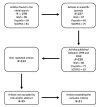The Relative Age Effects in Educational Development: A Systematic Review
- PMID: 34501556
- PMCID: PMC8431425
- DOI: 10.3390/ijerph18178966
The Relative Age Effects in Educational Development: A Systematic Review
Abstract
There is a large number of variables, studied in the literature, that affect the integral development of students in the educational stage, but few research analyze the effects that relative age can have on development. The aim of this study is to review and summarize the results obtained, on this subject, in recent research. The methodology used has followed the PRISMA declaration. The final sample is composed by 21 articles, which use data from 24 countries and 32 assessments. The main conclusions indicate that relatively younger children in same class groups: (a) obtain significantly lower mean scores in cognitive and motor tests, (b) have a higher repetition rate, and (c) have a less capacity of socialization. Finally, it should be noted that considering the results obtained by the research on relative age effect on child development, some authors propose to adapt educational practices to minimize these effects.
Keywords: age differences; developmental differences; education; educational process; systematic review.
Conflict of interest statement
The authors declare no conflict of interest.
Figures
References
-
- Pehkonen J., Viinikainen J., Böckerman P., Pulkki-Råback L., Keltikangas-Järvinen L., Raitakari O. Relative age at school entry, school performance and long-term labour market outcomes. Appl. Econ. Lett. 2015;22:1345–1348. doi: 10.1080/13504851.2015.1031864. - DOI
-
- Roberts S.J., Fairclough S.J. The Influence of Relative Age Effect in the Assessment of High School Students in Physical Education in the United Kingdom. EJournal Teach. Phys. Educ. 2012;31:56–70. doi: 10.1123/jtpe.31.1.56. - DOI
-
- Kawaguchi D. Actual age at school entry, educational outcomes, and earnings. J. Jpn. Int. Econ. 2011;25:64–80. doi: 10.1016/j.jjie.2009.02.002. - DOI
-
- Peña P.A. Creating winners and losers: Date of birth, relative age in school, and outcomes in childhood and adulthood. Econ. Educ. Rev. 2017;56:152–176. doi: 10.1016/j.econedurev.2016.12.001. - DOI
Publication types
MeSH terms
LinkOut - more resources
Full Text Sources
Medical





